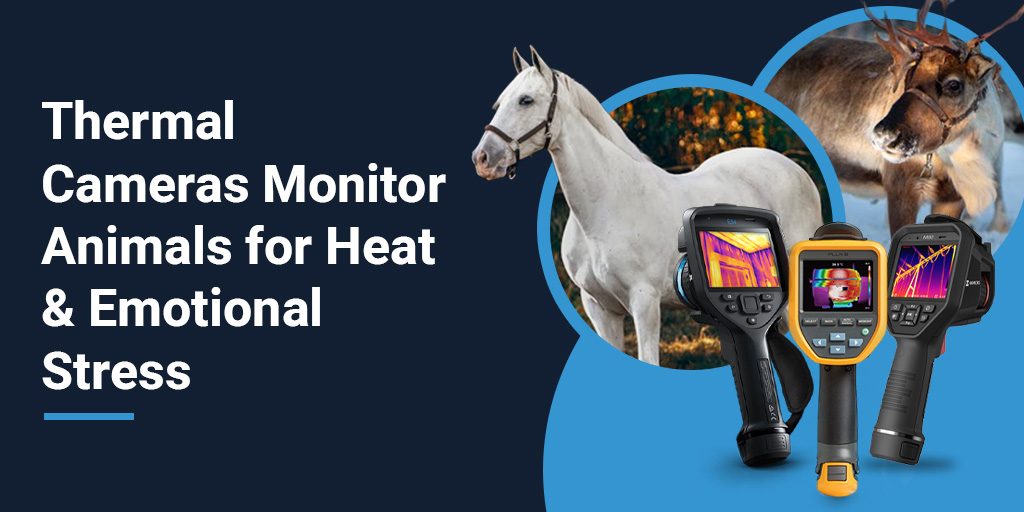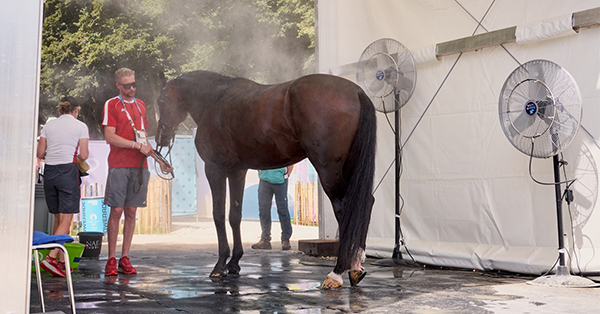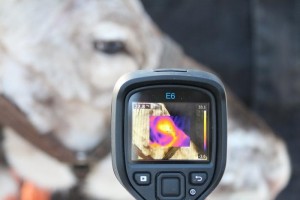
Specifically designed to detect heat/infrared energy, thermal cameras have proven useful across an array of sectors as disparate as utilities, construction, and manufacturing. In previous blogs, we have talked extensively about how thermal cameras can be used to rescue stray or lost animals, monitor species populations, and improve farming conditions. Now, thermal cameras are being used to monitor the emotional and physical well-being of competition horses and animals employed as part of tourist attractions. Discover how infrared imagers have been used to detect emotional stress in reindeer and learn how they were deployed to monitor horses for heat stress at the Paris 2024 Olympic and Paralympic Games.
Quick Links
- Thermal Cameras Ensure Cool Competition Horses
- Thermal Imaging Cameras Register Reindeers’ Stress
- Thermal Imaging Improves Animal Welfare
- Further Information
Thermal Cameras Ensure Cool Competition Horses

This summer the Paris 2024 Olympic and Paralympic equine events took place at Versailles.[1] To compensate for hot summer temperatures and ensure the welfare of horse competitors, the FEI (Fédération Equestre Internationale, the international governing body for most equine sports, including Olympic and Paralympic equestrian events[2]) implemented a plethora of climate mitigation protocols. These included continuous Wet Bulb Globe Temperature (WBGT) monitoring; thermal imaging and veterinary supervision; and cooling stations.
WBGT Monitoring
FEI Veterinary Director Göran Åkerström explains that:
“The FEI uses the Wet Bulb Globe Temperature (WBGT) index as a standard tool for assessing and managing thermal stress.
The WBGT Index measures solar radiation, ground heat reflection, humidity and windspeed, and is used by several sports as it is the most comprehensive index to monitor the climate’s effect on humans, and in our case, also horses.”
~ Göran Åkerström, FEI Veterinary Director
Continuous WBGT monitoring ensured veterinary teams could make informed decisions about the potential for heat stress amongst equine competitors throughout the games. Göran Åkerström pointed out:
“This precise method allows us to accurately gauge the potential for heat stress at events and implement the necessary measures to safeguard our horses’ and humans’ welfare. These measures get put in place once the WBGT index is higher than 28 degrees Celsius […]”
~ Göran Åkerström, FEI Veterinary Director
Thermal Imaging & Veterinary Supervision
A world-class team of vets used advanced thermal imaging cameras to monitor horses at warm-up and immediately after they returned from the arena/field of play. As thermal cameras enable non-contact monitoring and can detect hot spots or elevated temperatures indicative of heat stress from relatively far away, vets could monitor equine competitors from a safe distance less likely to exacerbate stress symptoms.
Cooling Stations
Five cooling stations were set up across Versailles’ Olympic venue. These were equipped with cold water, ice, fans, and equine professionals ready to help ensure rapid temperature reduction of horses post-performance.
The FEI’s climate mitigation protocols have been improved and refined since the 1996 Atlanta Olympic Games: the heat mitigation protocols were specifically designed for the Tokyo 2020 Olympics as these games were considered a high-risk environment. These protocols were adapted for Paris 2024 to great success as Göran Åkerström highlights:
“While we strive for all equestrian events to take place in optimal climatic conditions, it is often logistically challenging to achieve such conditions.
Thanks to our protocols, horses cooled down swiftly and displayed no signs of heat stress, underscoring the efficacy of our climate mitigation strategies.”
~ Göran Åkerström, FEI Veterinary Director
Thermal Imaging Cameras Register Reindeers’ Stress
Researchers from the University of Turku, Finland, and the University of Tours, France, have conducted a study into the efficacy of using thermal cameras to assess stress responses in reindeer.[3] The investigation aimed to see whether thermal imaging offers an accurate and effective method of monitoring stress responses in animals, in this case, reindeer.
The experiment was predicated on the theory that when animals encounter a stress stimulus, their bodies prepare for a fight-or-flight response. Consequently, blood is redirected to extremities like legs, which are crucial for running away, and diverted from organs or areas less pivotal to fight-or-flight, such as the eyes and nose. As a result of this shift in blood circulation, affected areas are likely to change temperature. In fact, previous research has shown that emotional stress causes a drop in the nose temperature of primates and humans. This temperature decrease was found to happen within seconds and could last up to several minutes.
Researchers from the Universities of Turku and Tours believed they may be able to detect similar temperature changes in reindeer using a thermal camera, especially if they are close to the skin. As such, the team chose to monitor the temperature around the reindeer’s eyes because they are fur-free.
The experiment consisted of eight male reindeer employed as part of the tourism trade in Lapland. Accustomed to the presence of humans but not to human touch, researchers chose to record the behavioural and thermal responses of these reindeer when stroked by a stranger for sixty seconds.

Scientists observed that the reindeer exhibited avoidance behaviour, such as moving away from the human and trying to dodge their touch, confirming that being petted was a stress stimulus. Thermal imaging revealed a decrease in the temperature around the corner of the reindeer's eyes while they were being stroked. This was followed by a gradual increase in temperature around the corner of the eye once the petting had ceased.
Based on these findings Postdoctoral Researcher Océane Liehrmann, who is the lead researcher of the study remarked:
“Our findings demonstrate that infrared thermal imaging can effectively capture the physiological stress responses of reindeer during human interactions. This technology allows us to monitor the emotional states of reindeer without invasive procedures.”
~ Océane Liehrmann, Postdoctoral Researcher at the University of Turku
Co-author of the study, Docent Martin Seltmann of the University of Turku also commented:
“By validating infrared imaging as a reliable assessment tool, we can improve the management and treatment of reindeer in tourism settings.”
~ Docent Martin Seltmann, University of Turku
Researchers believe this study “highlights the importance of using innovative technologies to enhance our understanding of animal stress and welfare.” Thermal cameras are especially useful for monitoring stress responses in animals because they facilitate a non-contact method of observation and data collection. Traditional methods, which involve collecting blood or saliva, can induce stress in animals due to the physical contact required to gather these samples. This could skew the data obtained from these samples. Thermal imaging eliminates this risk because researchers can maintain a safe, “stress-free” distance while capturing thermal footage and temperature measurements.
Thermal Imaging Improves Animal Welfare
In both stories reported in this blog, thermal imaging was used to improve animal welfare by monitoring changes in body temperature to detect heat or emotional stress. As thermal imaging offers a non-contact method of gathering temperature information, researchers, veterinarians, and other animal professionals can maintain a safe distance from creatures under their supervision, ensuring they do not exacerbate stressful conditions and/or influence temperature readings. Furthermore, as thermal cameras provide a visual indication of heat distribution, those caring for animals can see immediately if there are any stress indicators or other sources of discomfort, for example, lameness. This allows corrective action to be taken earlier, improving animal welfare, and reducing or potentially eliminating vet bills.

Below are a few more examples of how thermal imaging can improve animal welfare, whether by monitoring their physical health and living conditions or by protecting their habitats.
Catch Cattle Lameness with Economical Thermal Cameras
PASS Provides FLIR Thermal Camera for Poultry Farmer’s Barn Ventilation
Thermal Imaging Used to Tackle Wildfires
Thermal Cameras Used to Monitor Tree Health
Additionally, as thermal cameras rely on infrared energy rather than visible light to create an image, they are perfect for use in challenging environments and dim or dark conditions. Consequently, thermal imaging cameras have played an integral role in several animal rescue/recapture missions, conservation efforts, and ecology operations.
Thermal Camera Used to Find Feline
Guide Develops TK612 Thermal Camera Specifically for Bat Surveys
Thermal Cameras Help Locate Lovelorn Monkey
Thermal Camera Used to Rescue Kittens
How Thermal Imaging is Helping to Save a Species
Further Information
PASS Ltd is a leading provider of thermal imaging equipment including thermal cameras, thermal monoculars/binoculars, and thermal imaging drones. For more information or advice regarding any of these products, please don’t hesitate to contact our Sales team on 01642 931 329 or via our online form.
In the meantime, you can browse our collection of thermal products by leading brands such as FLIR, Guide, Hikmicro, and Pulsar below.
Thermal Monoculars & Binoculars
Thermal Drones, Cameras, & Gimbals
[1]Information and quotes for this section were gathered from the following source:
- FEI Communications, ‘Hot Hot Hot! Beating the Olympic Heat’, Horse Sport, last accessed 21 October 2024.
[2] Horse & Hound, FEI, last accessed 21 October 2024.
[3] Information and quotes for this section were gathered from the following source:
- Novus Light, Infrared Thermal Imaging Helps Assess Stress in Animals, last accessed 21 October 2024.


